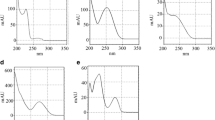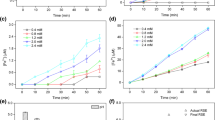Abstract
Acyclovir (ACV), an anti-virus drug, was widely detected in natural water at concentrations ranging from ng L−1 to μg L−1 due to inefficient biological treatments in sewage treatment plant. Photochemical experiments involving the irradiation from a xenon lamp simulating sunlight were conducted to explore the environmental behavior and potential risks of ACV. Isopropanol was used as a radical trapping agent for mechanism research, and the toxicity of the photoproducts of ACV was evaluated by the acute toxicity test of Photobacterium phosphoreum T3 spp. The results indicated that the ACV photodegradation followed pseudo first-order reaction kinetics, and the ACV removal rate increased when the pH was elevated from 5 to 10. The photochemical reaction pathway revealed by HPLC–MS/MS suggested that the C–C bond and C–N bond of ACV could be attacked by ·OH; thus, the photoproducts were mostly composed of hydroxyl substitution products. The intermediate photoproducts in the course of photodegradation exhibited a higher toxicity than the parent ACV, and the highest toxicity effect was observed at 6 h, which implied that the photoproducts of ACV might pose a great potential risk on aquatic environments.




Similar content being viewed by others
References
An T, An J, Gao Y, Li G, Fang H, Song W (2015) Photocatalytic degradation and mineralization mechanism and toxicity assessment of antivirus drug acyclovir: Experimental and theoretical studies. Appl Catal B Environ 164:279–287
Anne LB, Arnold WA, Mcneill K (2004) Photochemical fate of sulfa drugs in the aquatic environment: sulfa drugs containing five-membered heterocyclic groups. Environ Sci Technol 38(14):3933–3940
Barham RH, Drane W (1972) An algorithm for least squares estimation of nonlinear parameters when some of the parameters are linear. Technometrics 14(3):757–766
Boreen AL, Arnold WA, Mcneill K (2005) Triplet-sensitized photodegradation of sulfa drugs containing six-membered heterocyclic groups: identification of an SO2 extrusion photoproduct. Environ Sci Technol 39(10):3630
Chang EE, Liu TY, Huang CP, Liang CH, Chiang PC (2012) Degradation of mefenamic acid from aqueous solutions by the ozonation and O3/UV processes. Sep Purif Technol 98(39):123–129
Chen Y, Wu F (2011) Environmental photochemistry: theory and application. Res J Chem Environ 15(2):1–2
Chen Y, Liu Z, Wang Z, Xue M, Zhu X, Tao T (2011) Photodegradation of propranolol by Fe(III)–citrate complexes: kinetics, mechanism and effect of environmental media. J Hazard Mater 194(194):202–208
Chen P, Wang F, Chen ZF, Zhang Q, Su Y, Shen L, Yao K, Liu Y, Cai Z, Lv W (2017) Study on the photocatalytic mechanism and detoxicity of gemfibrozil by a sunlight-driven TiO2/carbon dots photocatalyst: the significant roles of reactive oxygen species. Appl Catal B Environ 204:250–259
Chong MN, Jin B, Chow CW, Saint C (2010) Recent developments in photocatalytic water treatment technology: a review. Water Res 44(10):2997–3027
Evgenidou EN, Konstantinou IK, Lambropoulou DA (2015) Occurrence and removal of transformation products of PPCPs and illicit drugs in wastewaters: a review. Sci Total Environ 505:905–926
Fu HL, Yao K, Wen YL, Guo GL, Ping C, Hao PH, Kang YP (2015) Photodegradation of ibuprofen under UV–Vis irradiation: mechanism and toxicity of photolysis products. Bull Environ Contam Toxicol 94(4):479–483
Hapeshi E, Achilleos A, Vasquez MI, Michael C, Xekoukoulotakis NP, Mantzavinos D, Kassinos D (2010) Drugs degrading photocatalytically: kinetics and mechanisms of ofloxacin and atenolol removal on titania suspensions. Water Res 44(6):1737–1746
Ji Y, Zeng C, Ferronato C, Chovelon JM, Yang X (2012) Nitrate-induced photodegradation of atenolol in aqueous solution: kinetics, toxicity and degradation pathways. Chemosphere 88(5):644–649
Kosma CI, Lambropoulou DA, Albanis TA (2014) Investigation of PPCPs in wastewater treatment plants in Greece: occurrence, removal and environmental risk assessment. Sci Total Environ 466–467(1):421–438
Li R, Kong J, Liu H, Chen P, Liu G, Li F, Lv W (2017) A sulfate radical based ferrous–peroxydisulfate oxidative system for indomethacin degradation in aqueous solutions. RSC Adv 7(37):22802–22809
Li R, Kong J, Liu H, Chen P, Su Y, Liu G, Lv W, Li R, Kong J, Liu H (2017) Removal of indomethacin using UV–vis/peroxydisulfate: kinetics, toxicity, and transformation pathways. Chem Eng J 331:809–817
Peng X, Wang C, Zhang K, Wang Z, Huang Q, Yu Y, Ou W (2014) Profile and behavior of antiviral drugs in aquatic environments of the Pearl River Delta. China. Sci Total Environ 466–467(1):755–761
Portilla D, Schnackenberg L, Beger RD (2007) Metabolomics as an extension of proteomic analysis: study of acute kidney injury. Semin Nephrol 27(6):609–620
Prasse C, Wagner M, Schulz R, Ternes TA (2011) Biotransformation of the antiviral drugs acyclovir and penciclovir in activated sludge treatment. Environ Sci Technol 45(7):2761–2769
Prasse C, Wagner M, Schulz R, Ternes TA (2012) Oxidation of the antiviral drug acyclovir and its biodegradation product carboxy-acyclovir with ozone: kinetics and identification of oxidation products. Environ Sci Technol 46(4):2169–2178
Russo D, Siciliano A, Guida M, Galdiero E, Amoresano A, Andreozzi R, Reis NM, Li PG, Marotta R (2017) Photodegradation and ecotoxicology of acyclovir in water under UV254 and UV254/H2O2 processes. Water Res 122:591
Song W, Cooper WJ, Peake BM, Mezyk SP, Nickelsen MG, O’Shea KE (2009) Free-radical-induced oxidative and reductive degradation of fluoroquinolone pharmaceuticals: kinetic studies and degradation mechanism. J Phys Chem A 113(7):1287–1294
Suzuki J, Sato T, Ito A, Suzuki S (1990) Mutagen formation and nitration by exposure of phenylphenols to sunlight in water containing nitrate or nitrite ion. Bull Environ Contam Toxicol 45(4):516–522
Wang F, Chen P, Feng Y, Xie Z, Liu Y, Su Y, Zhang Q, Wang Y, Yao K, Lv W (2017) Facile synthesis of N-doped carbon dots/g-C3N4 photocatalyst with enhanced visible-light photocatalytic activity for the degradation of indomethacin. Appl Catal B Environ 207:103–113
Wang Z, Yao K, Wang F, Chen Z, Chen P, Kong Q, Wenying L, Liu G (2017) Photodegradation of acyclovir in aquatic environment: effect of different forms of nitrogen. Environ Chem 36(2):214–220
Werner JJ, Arnold WA, McNeill K (2006) Water hardness as a photochemical parameter: tetracycline photolysis as a function of calcium concentration, magnesium concentration, and pH†. Environ Sci Technol 40(23):7236–7241
Yang L, Yu LE, Ray MB (2008) Degradation of paracetamol in aqueous solutions by TiO2 photocatalysis. Water Res 42(13):3480–3488
Zhou C, Chen J, Xie Q, Wei X, Zhang YN, Fu Z (2015) Photolysis of three antiviral drugs acyclovir, zidovudine and lamivudine in surface freshwater and seawater. Chemosphere 138:792–797
Acknowledgements
This research was funded by the Natural Science Foundation of Guangdong Province, China (2016A030313697) and the National Natural Science Foundation of China (Nos. 21377031, 41573094, 21677040).
Author information
Authors and Affiliations
Corresponding authors
Additional information
Publisher's Note
Springer Nature remains neutral with regard to jurisdictional claims in published maps and institutional affiliations.
Rights and permissions
About this article
Cite this article
Jia, TC., Guo, JT., Wang, Z. et al. Photodegradation mechanisms of acyclovir in water and the toxicity of photoproducts. J Radioanal Nucl Chem 320, 823–830 (2019). https://doi.org/10.1007/s10967-019-06543-4
Received:
Published:
Issue Date:
DOI: https://doi.org/10.1007/s10967-019-06543-4




